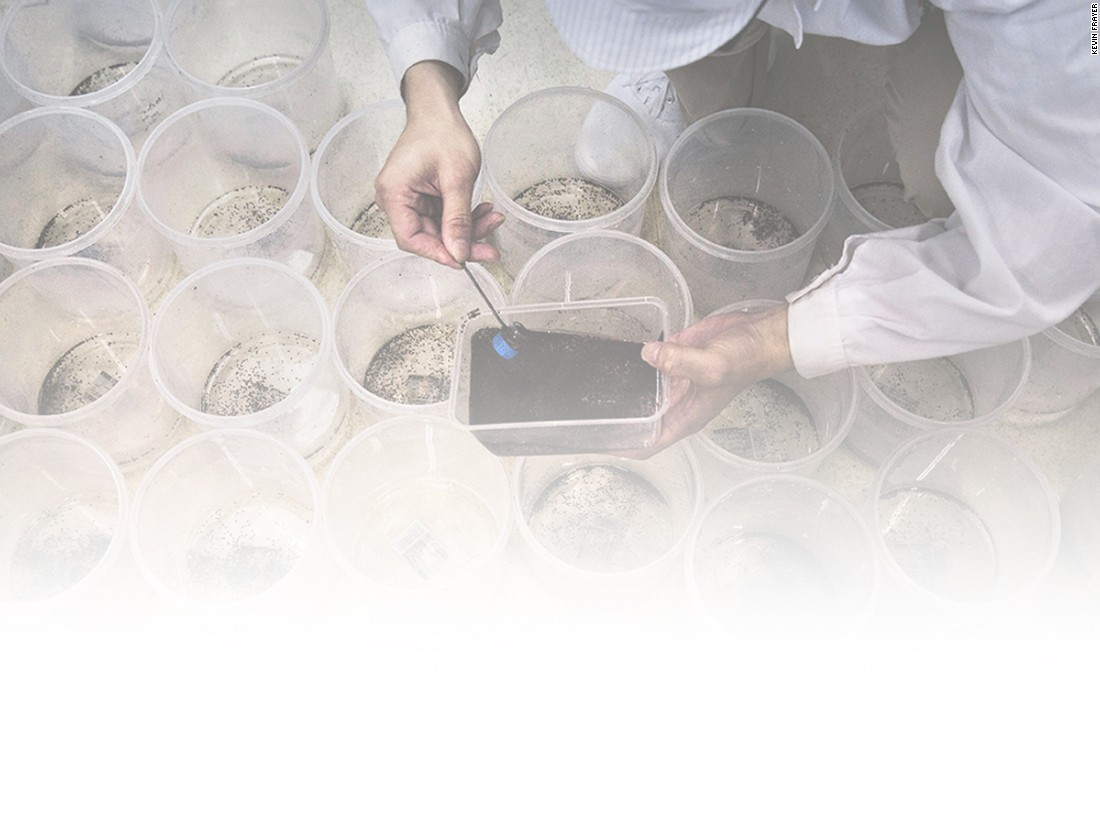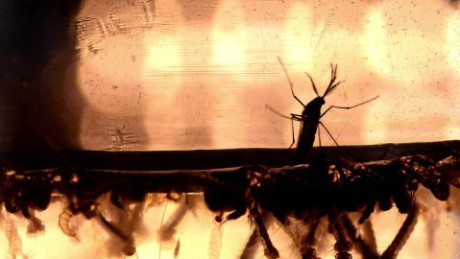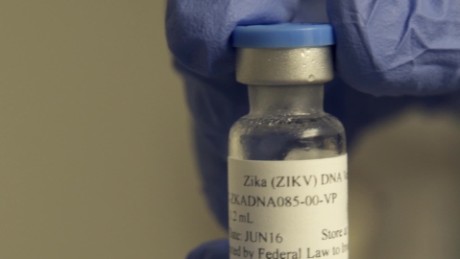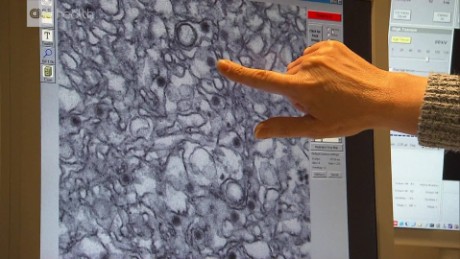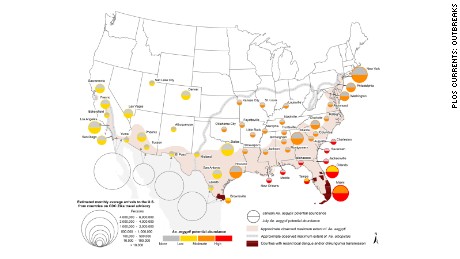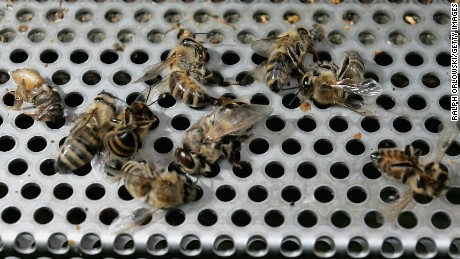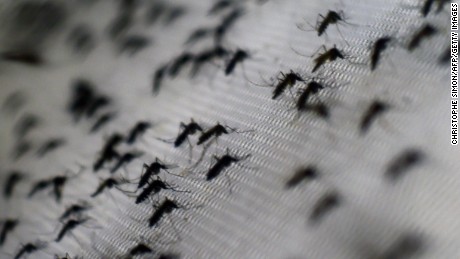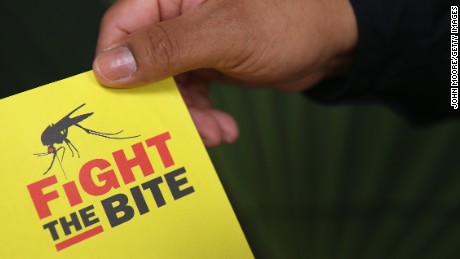Inside China's 'mosquito factory' fighting Zika and dengue
Updated 1148 GMT (1948 HKT) December 28, 2016
Story highlights
- At this lab, technicians are breeding up to 5 million Aedes albopictus mosquitoes a week
- They're part of a plan to eliminate some of the common mosquito-borne diseases
Guangzhou, China (CNN)Zhiyong Xi is a man on a mission.
He wants to rid China -- and potentially the world -- of mosquitoes, specifically the ones that carry devastating diseases like Zika and dengue. And he's doing it in the classic style of good versus evil.
"We're building good mosquitoes that can help us fight the bad ones," the entomologist said in his 3,500-square-foot laboratory in Guangzhou, China.
Decked out in white scrubs, Xi, a soft-spoken researcher from Michigan State University, gestures at hundreds of trays, each filled with about 6,000 squirming mosquito larvae. The room reeks of ground beef liver powder cut with yeast, a superfood for the tiny creatures.
This "mosquito factory" is on Sun Yat-Sen University's science campus, about an hour's drive from the bustle of Guangzhou city center.
The center's full name is the Sun Yat-Sen-Michigan State University Joint Center of Vector Control for Tropical Disease, and here, lab technicians are breeding up to 5 million Aedes albopictus mosquitoes a week -- a species more common in Asia, responsible for spreading both dengue and Zika.
The mosquitoes have been infected with bacteria that prevent them from transferring viruses such as dengue to humans. Only the males of the group are being released because the bacteria, Wolbachia, makes them sterile, so the wild females they mate with lay eggs that won't hatch.
These males have now been released on Shazai island, a village 37 miles (60 kilometers) from the factory. A 300-meter (984 feet) bridge separates the village of 1,900 people from the mainland, and according to Xi, the isolated location keeps incoming mosquito populations at bay: Mosquitoes can fly 50 to 75 meters (164 to 246 feet) at most.
Xi expects this technique to lead to a massive reduction in the number of mosquitoes.
Although his method is unconventional, some scientists are hailing it as one of the most promising ways to eliminate two of the most common mosquito-borne diseases that affect millions each year.
Mosquito vs. mosquito
The Zika virus has spread to more than 60 countries and territories. Pregnant women are most at risk because the virus can cause the devastating birth defect microcephaly and other neurological deficits that require a lifetime of care.
It's the only known mosquito-borne disease to cause a birth defect.
As is the case with Zika, most people infected with dengue fever don't know it, because they don't have symptoms. Dengue infects 390 million people a year, and although unusual, it can be fatal.
But tackling both of these diseases has been tricky.
An anti-dengue vaccine is licensed for use in six countries in Asia and Latin America, however, some experts warn that it could actually lead to an increase in cases if not rolled out correctly, as it's more likely to be severe the second time someone contracts dengue.
A vaccination for Zika is still being developed.
"Vaccine development is a long journey," said Eng Eong Ooi, the deputy director of the Emerging Infectious Disease program at Duke-NUS Medical School in Singapore.
"It not only takes time to develop vaccine candidates, but showing that the vaccine is safe and protects against disease in humans will also require a few years."
Aware of the pitfalls of developing vaccinations, Xi is part of a growing task force of researchers who prefer instead to turn dangerous mosquitoes against one another.
Xi has worked with Wolbachia-infected Aedes aegypti mosquitoes since 2005, and in China, he's adapted his methods to deal with the Aedes albopictus, which are more common in Southeast Asia.
He'll soon be taking his technology global. With the help of a $1 million grant from the United States Agency for International Development, he plans to set up a similar mosquito factory in Mexico in March.
But Xi isn't the only researcher exploring this promising field.
Eliminate Dengue, a nonprofit research collaboration that's been active in Indonesia and Australia, received an $18 million grant in October to launch a Wolbachia-infected Aedes aegypti mosquito release program in Brazil and Colombia. It focuses on establishing a new population of Wolbachia-infected mosquitoes -- that will be unable to spread these viruses -- into the environment as opposed to eliminating them like Xi does.
In the world of biotechnology, UK-based company Oxitec received authorization from Florida Keys residents to release genetically modified mosquitoes there in the fight against Zika in early 2017.
A truly 'surreal place'
As Xi spends most of his time in the US, it's mainly an army of young lab technicians with bioengineering, entomology and pharmaceutical backgrounds who staff his factory.
Chen Chunping, whose eyes were barely visible behind a voluminous face mask and scrub cap, said she was initially shocked when she saw the factory, a labyrinthine space with multiple rooms dedicated to the research and mass production of mosquitoes.
"I thought it was a surreal place that came out of a science fiction plot, but I soon got used to it," said Chen, who heads the mosquito feeding program.
But mass-rearing millions of mosquitoes is no easy task.
Making the mosquitoes
Researchers start by injecting Wolbachia into mosquito eggs under a microscope to establish their first generation of infected mosquitoes. These mosquitoes then breed and produce more eggs to be harvested, which are grown in water-filled trays until they morph into larvae.
Once they become pupae, researchers manually separate the males from the females through a glass sieve-like contraption in the "sex separation" room for about four hours each day.
The larger females get caught in the sieve while slimmer males slide into the water beneath. Lab assistants destroy the females while males are packaged in plastic containers so that they can grow into adult mosquitoes that can be readied for release.
In the factory, lab assistants take swipes at rogue female mosquitoes that have escaped their cages with electric rackets.
"We get bitten all the time," entomologist Li Yongjing said with a grin.
Island lab
Xi's team of lab technicians makes the hour-long journey to Shazai Island three times a week.
The community assistants who live alongside the villagers here also monitor the population of mosquitoes on Shazai Island to evaluate the program's success rate.
They dot ovitraps -- lantern-like devices that mimic the preferred breeding ground for female mosquitoes -- around Shazai. Each week, they extract eggs laid in the ovitraps and place them in incubators to see if they will hatch. Another set of traps is designed to capture wild female mosquitoes, whose numbers should also be in decline.
"Based on the number of eggs laid in the trap and the hatch rate, we know how well the population has been suppressed," Xi said.
Villagers weren't always welcoming of the scientists and their buzzing friends.
Perched on a small red stool outside her home, Ruiying Liang said she'd initially felt uncomfortable about the idea of researchers releasing yet more mosquitoes on an island already infested with them.
But her fear of contracting dengue, a painful disease sometimes called break-bone fever, helped her eventually overcome her skepticism. In 2014, Guangdong province had its most serious dengue outbreak in decades, with a record 45,224 cases.
"It felt strange at first, but I did notice fewer mosquitoes around with time," she said.
These days, Liang barely registers when the community assistants ride by on their two-seater motorbikes, releasing mosquitoes as they pass.
Keeping the community's trust, however, remains an issue. Before releasing the mosquitoes, Xi and his team spent a year telling the villagers about the release program to convince them of the benefits of his research.
A permanent outpost of community assistants are on hand to respond to queries from locals and to act as goodwill ambassadors for Xi's project, assuaging any concerns.
Does it work?
So far, members of Xi's team claim that they have suppressed the mosquito population on the island by a whopping 96%, but scientists have questioned whether he will be able to scale up his island experiment in larger areas.
Raman Velayudhan, an infectious disease expert at the World Health Organization, said that although Xi's research was promising, he must bear in mind the Aedes mosquito's tenacious survival skills.
"It really isn't that easy to eliminate a population of mosquitoes," he said.
Velayudhan says that Xi might succeed in suppressing the mosquito population in a particular area, but Aedes mosquitoes can lay up to 150 eggs every three days up to 10 times during their lifespan.
These eggs, he warned, can remain alive for up to a year in secluded dry spots, hatching when they encounter moisture.
"How will (Xi) scale up the control method?" Velayudhan asked.
Aware of the challenges, Xi said that his project will consider the rate at which mosquitoes return to the island -- if they do -- once the current population has been eliminated.
However, Velayudhan says that in some cases, a decline in mosquito populations still doesn't stop diseases from spreading.
"The main problem with Zika is that even when the number of infected mosquitoes is low, they can sustain disease transmission," he said.
"This is one of the biggest challenges that we have in the scientific world."
But despite the obstacles, Xi's techniques recently impressed a visiting team of Mexican researchers, who were being trained to release their own Zika-fighting mosquito army in 2017.
Tell us your story
Tell us your story
We love to hear from our audience. Follow @CNNHealth on Twitter and Facebook for the latest health news and let us know what we're missing.
"We've seen how the people in China reacted to Xi's method, and we also think we'll have a good reaction in Mexico," said Pablo Manrique, a biologist from the Autonomous University of Yucatan.
Next, Xi wants to expand his project to more densely populated areas and use drones and helicopters to drop the mosquitoes onto cities being targeted.
"It's just like in the military where you need an air force and troops on the ground," Xi said. "Ultimately, we want to scale up our operations to save lives."

